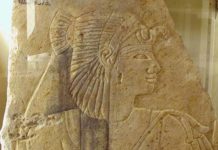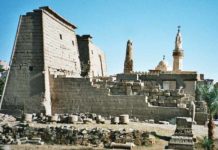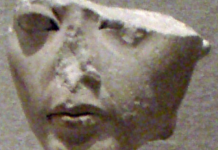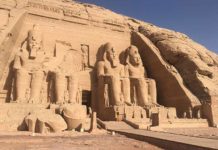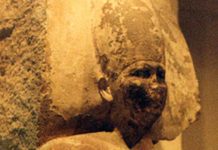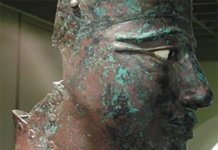The army of the Middle Kingdom (2055 – 1650 BC) was an infantry force – horses had not yet been introduced to Egypt.
Troop types
There were two types of soldier: archers and melee (close-combat) infantry. They were mostly men in their youth, recruited in their late teens to undergo a strenuous training regimen that placed a high emphasis on wrestling skills and physical fitness. Men had to march carrying their equipment and rations and perhaps still be ready to fight a battle afterwards.
Melee infantry
These were soldiers equipped with spears, battle-axes and daggers. Spears were as long as a man was tall, with broad leaf-bladed copper heads tang mounted into wooden shafts. The point at which the tang was inserted into the shaft would be reinforced with rawhide strips to prevent the shaft splitting. They could be thrown or used as a thrusting weapon.
Battle-axes possessed a D shaped copper or bronze blade mounted on a wooden haft. The blade would be affixed to the handle with wet rawhide straps that shrank as they dried, ensuring a tight, secure fit.
Daggers could be crafted from bone, flint or copper. They mimicked the size and shape of spear-heads and were carried either tucked into the soldiers loincloth or in a sheath strapped to the left forearm.
Soldiers would also have a shield,1 – 1.5 metres in height, made from cowhide stretched over a wooden framework. With a characteristic arched shape, they were held by a single handgrip and were tough enough to absorb the impact of most period weapons. Indeed, modern research has revealed that it is often easier to penetrate metals such as bronze than leather or rawhide.
Archers
Archers wielded simple bows, usually fashioned from acacia wood and 1-2 metres in length. They were not particularly powerful, with an effective range of 50-60 metres. Bowstrings were of animal gut or linen. Virtually identical bows are still fairly commonplace in many parts of Africa today.
Arrows were made from reed. A variety of materials were employed for arrowheads; the exhumed skeletal remains of soldiers killed in battle have revealed that ebony, a native hardwood, was commonly used to make arrowheads, as well as flint, bone and copper. Like spears, arrowheads would be tang mounted into their shafts. A fletching of trimmed bird feathers would complete the ensemble.
Quivers made from cowhide did exist but it appears that many archers preferred to carry their arrows bundled up in one hand. Archers wore a leather bracer on their left forearm to protect the skin as the bowstring whipped forward when released. Spare bowstrings were usually tied around the archers head.
Most archers carried a leather ‘kitbag’ to hold such accessories as pebbles for sharpening arrowheads, and lumps of malachite. The malachite was ground into a powder which was thickened with fat and water. This greenish paste was smeared beneath the archers eyes, presumably to protect them from glare.
Nubians, from what is now Sudan, were highly prized as archers.
Battles
Soldiers would draw up in rough lines, with the Commander and his staff in the centre and archers out on the flanks and rear. Archers would loose showers of arrows at the foe before the spearmen and axe-men closed for hand-to-hand fighting. There is little evidence that spearmen stood in a shield wall or phalanx – melee was a rough and tumble affair, knots of men grappling, hacking, stabbing and gouging at each other in a squalid brawl until one side was victorious.
Despite the simple weaponry, casualties in big battles must have been high as Middle Kingdom soldiers wore no armour whatsoever and their sole item of clothing was a basic loincloth, or kilt, of linen.
Isolated by their natural borders, the equipment and tactics of these early Egyptian soldiers were adequate for expeditions mounted against local enemies such as the Nubians, desert tribesmen or civil war. The invasion and subjugation of Egypt by the Hyksos in 1660-1550 BC would see the introduction of chariots, horses, armour, swords and better bows.



